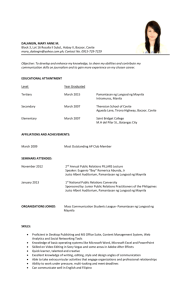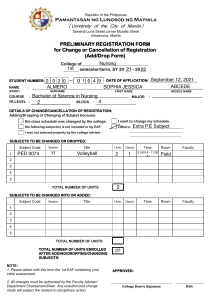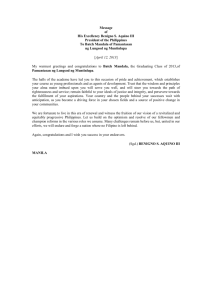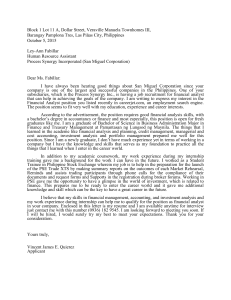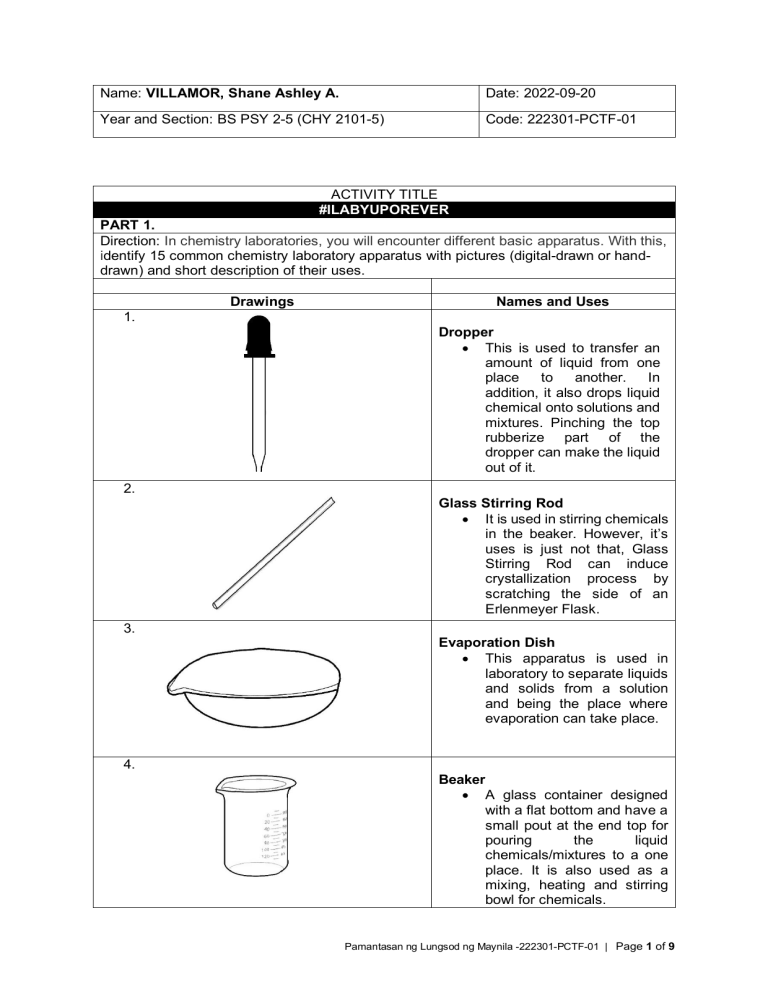
Name: VILLAMOR, Shane Ashley A. Date: 2022-09-20 Year and Section: BS PSY 2-5 (CHY 2101-5) Code: 222301-PCTF-01 ACTIVITY TITLE #ILABYUPOREVER PART 1. Direction: In chemistry laboratories, you will encounter different basic apparatus. With this, identify 15 common chemistry laboratory apparatus with pictures (digital-drawn or handdrawn) and short description of their uses. Drawings Names and Uses 1. Dropper • This is used to transfer an amount of liquid from one place to another. In addition, it also drops liquid chemical onto solutions and mixtures. Pinching the top rubberize part of the dropper can make the liquid out of it. 2. Glass Stirring Rod • It is used in stirring chemicals in the beaker. However, it’s uses is just not that, Glass Stirring Rod can induce crystallization process by scratching the side of an Erlenmeyer Flask. 3. Evaporation Dish • This apparatus is used in laboratory to separate liquids and solids from a solution and being the place where evaporation can take place. 4. Beaker • A glass container designed with a flat bottom and have a small pout at the end top for pouring the liquid chemicals/mixtures to a one place. It is also used as a mixing, heating and stirring bowl for chemicals. Pamantasan ng Lungsod ng Maynila -222301-PCTF-01 | Page 1 of 9 5. Graduated Cylinder • It is used to measure volumes and is more accurate way to measure it instead of using a typical beaker or a flask. 6. Erlenmeyer • A chemistry flask designed with a conical shaped body that is used to hold liquids for mixing, heating, cooling, incubation, filtration, storage and other liquid-handling processes. 7. Test Tube • It is a type of glassware or plastic ware that can be found in laboratories that is used for holding, mixing, and heating small amount of liquid chemicals since a test tube is a lot smaller that the other flasks. 8. Test Tube Rack • It is a rack that is made to hold multiple test tubes especially when there are a lot of chemicals used in an experiment. Pamantasan ng Lungsod ng Maynila -222301-PCTF-01 | Page 2 of 9 9. Test Tube Holder • These clamps were used to grasp the test tubes when used to heat up chemicals. 10. Tongs • This is used for holding and lifting materials of heatresistant objects used in high temperature chemical reactions. They are also used in removing and handling heated containers 11. Mortar and Pestle • The pestle is used to crush and grind solid chemicals onto smaller pieces or turn it into a powder. The mortar on the other hand is the bowl in which crushing by the pestle takes place. 12. Thermometer • It is used to determining the temperature of a mixture of substance when heated or cooled. 13. Watch Glass • It is a type of glass dish that is used for evaporation of chemicals. Pamantasan ng Lungsod ng Maynila -222301-PCTF-01 | Page 3 of 9 14. Wire Gauze • This is used to support flasks or a beaker when heating. Some glass wares are sensitive to heat and might be broken. In this case, Wire gauze is the one who helps it and it also spreads heat evenly at the bottom of the flask while heating. 15. Funnel • It helps to pour substance in a container or flask without spilling it. On the other hand, these funnels are often used to separate mixture with a filter. 16. Bunsen Burner • This apparatus is used for heating and sterilizing. It produces flame that can heat chemicals and sterilize other materials. 17. Burette • It is a kind of laboratory apparatus used in measuring volume of a liquid or a gas used in chemistry. It is also used to analyze the chemical quantitative of a substance. Pamantasan ng Lungsod ng Maynila -222301-PCTF-01 | Page 4 of 9 18. Electronic Balance • This apparatus is used in determining the accurate measurement of weight of materials and chemicals. 19. Ring Stand • It is used to give support for other equipment. However, it is often used to hold iron rings and provide flasks for it to stand balanced while doing mixtures or any chemical processes. 20. Iron Ring • This is often partnered with Iron Ring Stand and is used in supporting and holding flasks or funnels upright in the ring stand. PART 2. Direction: Search for the MSDS of the following chemicals and provide the chemical symbol and brief hazardous identification of each chemical. Chemical Name Hydrochloric Acid Chemical Symbol HCL Hazards • Health Hazards - Very hazardous when it comes in contact with the skin, eyes and of ingestion. On the other hand, in case the person has inhaled the gas produced by the chemical it is just only slightly hazardous. - Liquid or Spraying of the chemical can cause tissue Pamantasan ng Lungsod ng Maynila -222301-PCTF-01 | Page 5 of 9 - - Sodium hydroxide Methanol NaOH CH4O damages specifically on the part of the eyes, mouth and when inhaled in the respiratory tract. Sever over exposure to the product can lead to death. This substance may be poisonous to the Circulatory system and also to kidneys, livers and upper respiratory tract. HCL was identified to have Carcinogenic Effects: Classified 3 but not classifiable for human by IARC. HCL Hazard Classification • Health Hazards - In case of skin contact ,of the eye, of ingestion and of inhalation, it is very hazardous. When in touch with the eye, it can cause blindness. On the other hand, if it is in contact with skin it can cause inflammation. When inhaled in will make irritation to the lungs/ respiratory tract. Classified to have Mutagenic Effects; Mutagenic for mammalian somatic cells. • NaOH Hazard Classification Health Hazards - In case of contact with the skin and eye, and ingested and inhaled it is hazardous to the body. - Sever over-exposure with the substance can result in death. - Classified to obtain Mutagenic Effects: Mutagenic for mammalian somatic cells. Pamantasan ng Lungsod ng Maynila -222301-PCTF-01 | Page 6 of 9 • Toluene C6H5CH3 • • Hexane C6H14 Mutagenic for bacteria and/or yeast. - Classified to have Teratogenic Effects: Possible for human. Fire Hazards - Material is Flammable and is highly flammable in presence of open flames and sparks of heat. Explosive in attendance of flames and sparks of heat. Methanol Hazard Classification Health Hazards - Hazardous in case of skin contact, of ingestion, of inhalation. - Classified to have Carcinogenic Effects: A4 and 3. - The material can be toxic to blood, kidneys, the nervous system and more. Fire Hazards - The Chemical is Flammable in presence of open flames and sparks. - Material creates explosive reaction to various chemical properties. Toluene Hazard Classification • Health Hazards - Hazardous in case of skin contact, of ingestion, of inhalation. - Classified to have Mutagenic Effects: Mutagenic for bacteria and/or yeast. - The substance may be harmful to the peripheral system, skin and central nervous system. Hence repeated or prolonged Pamantasan ng Lungsod ng Maynila -222301-PCTF-01 | Page 7 of 9 • Acetone C3H6O • • vulnerability to the material can cause severe damage Fire Hazards - Substance is Flammable and is HIGHLY flammable in existence of open fires and sparks, of heat. - It is insoluble in water and is extremely flammable liquid and vapor that can cause flash fire. Hexane Hazard Classification Health Hazards - Hazardous in case of skin contact, of ingestion, of inhalation. - Classified to have Carcinogenic Effects: A4 - Classified to have Developmental Toxicity: Suspected to affect Reproductive system/toxin/female and male. Fire Hazards - Substance is Flammable and is HIGHLY flammable in existence of open fires and sparks, of heat. - It is slightly explosive in the exposure with flames and sparks of oxidizing materials and of acids. - Vapor produced can cause ignition and flash of fire Acetone Hazard Classification References: PART 2 • Hydrochloric Acid; MSDS No. SLH1462 [Online]; Sciencelab.com, Inc. Smith Rd. Houston, Texas, Nov 11, 2010. http://www.nano.pitt.edu/sites/default/files/MSDS/Acids/Hydrochloric%20Acid.pdf (Accessed Sept. 20, 2022). Pamantasan ng Lungsod ng Maynila -222301-PCTF-01 | Page 8 of 9 • • • • Sodium Hydroxide; MSDS No. SLS3298 [Online]; Sciencelab.com, Inc. Smith Rd. Houston, Texas, Nov 11, 2010. http://microfluidics.cnsi.ucsb.edu/wiki/lib/exe/fetch.php?media=wiki:msds:naoh.pdf (Accessed Sept. 20, 2022). Methanol; MSDS No. SLM3064 [Online]; Sciencelab.com, Inc. Smith Rd. Houston, Texas, Nov 11, 2010. http://dept.harpercollege.edu/chemistry/msds/Methyl%20alcohol%20ScienceLab.pdf (Accessed Sept. 20, 2022). Toluene; MSDS No. SLT2857 [Online]; Sciencelab.com, Inc. Smith Rd. Houston, Texas, Nov 11, 2010. http://dept.harpercollege.edu/chemistry/msds/Toluene%20ScienceLab.pdf (Accessed Sept. 20, 2022). Acetone; MSDS No. SLA3502 [Online]; Sciencelab.com, Inc. Smith Rd. Houston, Texas, Nov 11, 2010. http://dept.harpercollege.edu/chemistry/msds/Acetone%20ScienceLab.pdf (Accessed Sept. 20, 2022). PART 1 o https://healthfully.com/113694-uses-medicine-dropper.html o http://www.orgchemboulder.com/Technique/Equipment/Benchglass/Stirrod.sht ml o https://www.homesciencetools.com/chemistry/glasswareplasticware/evaporating-dishes-test-plates/ o https://www.ducksters.com/science/chemistry/chemistry_lab_equipment.php o https://www.globalspec.com/learnmore/labware_scientific_instruments/labware _consumables/laboratory_tongs#:~:text=Laboratory%20tongs%20are%20large %20pincers,crucibles%2C%20and%20other%20laboratory%20apparatuses. o https://americanhistory.si.edu/collections/search/object/nmah_1096#:~:text=A %20watch%20glass%20is%20a,lid%20for%20flasks%20and%20beakers . o https://laboratoryapparatus.weebly.com/commonly-used-labequipment.html#:~:text=In%20a%20chemistry%20laboratory%2C%20an,while %20testing%20is%20being%20performed.&text=A%20ring%20stand%20is%2 0used,equipment%20above%20the%20work%20surface. o https://www.persistencemarketresearch.com/market-research/laboratoryelectronic-balancemarket.asp#:~:text=Electronic%20balance%20is%20an%20instrument,provide s%20digital%20result%20of%20measurement. Pamantasan ng Lungsod ng Maynila -222301-PCTF-01 | Page 9 of 9
